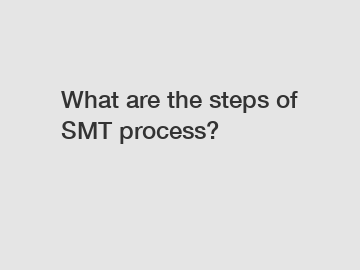What are the steps of SMT process?
Surface mount technology (SMT) is a key manufacturing process used in the electronics industry to assemble components onto printed circuit boards (PCBs). It offers several benefits over through-hole technology, including smaller size, higher component density, and better electrical performance. In this blog post, we will discuss the steps involved in the SMT process.
Step 1: Stencil Printing.
The first step in the SMT process is stencil printing, where solder paste is applied to the PCB using a stencil. The stencil is made of stainless steel and has openings that match the footprint of the components on the PCB. Solder paste is applied through the stencil using a squeegee, ensuring precise placement of the paste on the board.

Step 2: Pick and Place.
After the solder paste is applied, the next step is pick and place, where components are placed onto the PCB. This is done using automated pick and place machines, which use vision systems to accurately place components onto the board. Components are picked up from reels or trays and placed onto the PCB with precision and speed.
Step 3: Reflow Soldering.
Once all components are placed on the PCB, the board goes through a reflow soldering process. In this step, the board is heated in a reflow oven, melting the solder paste and creating a permanent bond between the components and the board. The temperature profile in the reflow oven is carefully controlled to ensure proper soldering and avoid damage to the components.
Step 4: Inspection.
After reflow soldering, the board goes through inspection to check for any defects or soldering issues. Automated optical inspection (AOI) machines are used to inspect the board for missing or misaligned components, solder bridges, and other defects. Any issues identified during inspection are addressed before moving on to the next step.
Step 5: Cleaning.
After inspection, the PCB goes through a cleaning process to remove any residual flux or contaminants from the board. Cleaning is important to ensure the long-term reliability of the finished product. Various cleaning methods are used, including aqueous cleaning, vapor degreasing, and ultrasonic cleaning, depending on the requirements of the application.
Step 6: Testing.
The final step in the SMT process is testing, where the assembled PCB is tested to ensure that it meets the required specifications and functions correctly. Functional testing, in-circuit testing, and boundary scan testing are some of the methods used to test PCBs. Testing helps to identify any issues that may have been missed during earlier stages of the process.
In conclusion, the steps involved in the SMT process are crucial for producing high-quality electronic products. By following these steps carefully and using advanced equipment and technology, manufacturers can ensure efficient and reliable assembly of components onto PCBs. SMT has revolutionized the electronics industry by enabling smaller, more powerful devices to be produced at a lower cost. As technology continues to advance, the SMT process will continue to evolve to meet the demands of the ever-changing electronics market.
If you are looking for more details, kindly visit Tht Pcb Assembly, Smt Component Package Sizes, High Quality Adjustable Speed Smt Conveyor.
124
0
0


Comments
All Comments (0)